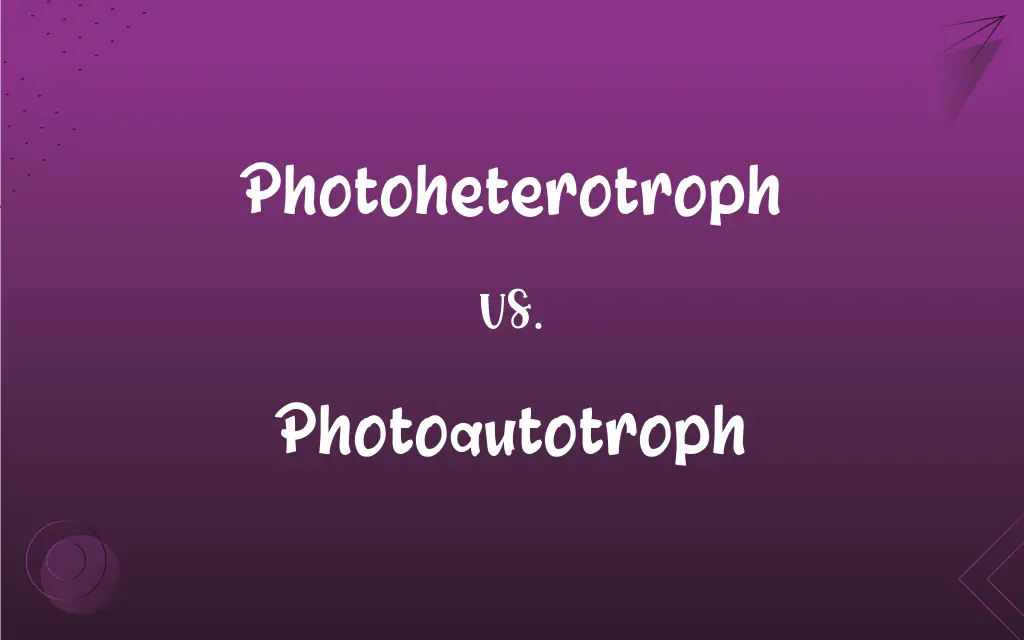Photoheterotroph vs. Photoautotroph: What's the Difference?
By Aimie Carlson & Harlon Moss || Updated on May 29, 2024
Photoheterotrophs obtain energy from light but require organic compounds for carbon, while photoautotrophs derive energy from light and synthesize their own organic compounds from CO2.

Key Differences
Photoheterotrophs rely on light for energy but cannot use carbon dioxide as their sole carbon source. Instead, they need organic compounds from their environment. Photoautotrophs, on the other hand, use light as their energy source and carbon dioxide as their carbon source. They synthesize their own organic compounds through photosynthesis.
In photoheterotrophs, light energy is utilized primarily for ATP production, while the necessary organic carbon compounds are often obtained from decomposing organic material or preformed organic molecules. Photoautotrophs possess specialized pigments like chlorophyll to capture light energy and convert it into chemical energy, producing organic molecules from inorganic carbon sources. This ability enables them to thrive in a wide range of environments, contributing significantly to global carbon cycling and oxygen production.
While photoheterotrophs are often found in environments rich in organic material, such as soil and aquatic habitats, photoautotrophs are widely distributed across various ecosystems, including terrestrial and marine environments, due to their capability to utilize inorganic carbon.
Photoheterotrophs play a unique role in their ecosystems by contributing to the recycling of organic material, whereas photoautotrophs form the base of most food webs, supporting a vast array of life forms through primary production.
Comparison Chart
Energy Source
Light
Light
ADVERTISEMENT
Carbon Source
Organic compounds
Carbon dioxide (CO2)
Example Organisms
Certain bacteria like purple non-sulfur bacteria
Plants, algae, cyanobacteria
Role in Ecosystem
Recycle organic material
Primary production, oxygen generation
Pigments
Various pigments for light absorption
Chlorophyll and other photosynthetic pigments
Photoheterotroph and Photoautotroph Definitions
Photoheterotroph
An organism that uses light for energy but requires organic compounds for carbon.
Some bacteria are photoheterotrophs, using light and organic matter for growth.
ADVERTISEMENT
Photoautotroph
An organism that uses light for energy and carbon dioxide as its carbon source.
Most plants are photoautotrophs, converting CO2 into organic matter.
Photoheterotroph
Uses light energy to generate ATP but depends on organic carbon sources.
Photoheterotrophs utilize organic compounds alongside light for energy.
Photoautotroph
Forms the base of food webs, supporting other life forms through primary production.
Algae in oceans are vital photoautotrophs for marine ecosystems.
Photoheterotroph
Often found in environments rich in organic compounds and light.
Aquatic sediments host various photoheterotrophic bacteria.
Photoautotroph
Capable of photosynthesis, producing organic molecules from inorganic carbon.
Cyanobacteria are photoautotrophs that produce oxygen.
Photoheterotroph
Cannot fix carbon dioxide independently, needing organic sources instead.
Photoheterotrophs need organic substrates from the environment to thrive.
Photoautotroph
Contains chlorophyll to capture light energy and convert it to chemical energy.
Photoautotrophs like plants use chlorophyll for photosynthesis.
Photoheterotroph
Relies on environmental organic material while utilizing sunlight for energy.
Purple non-sulfur bacteria are photoheterotrophs found in soil.
Photoautotroph
Can thrive in various environments, from terrestrial to aquatic.
Photoautotrophs are found in diverse habitats, from forests to oceans.
Photoheterotroph
A heterotrophic organism that uses light for energy but cannot use carbon dioxide as its sole carbon source and thus uses organic compounds from the environment.
Photoautotroph
See phototroph.
Photoautotroph
(biology) an organism, such as all green plants, that can synthesize its own food from inorganic material using light as a source of energy
FAQs
What is the main difference between photoheterotrophs and photoautotrophs?
Photoheterotrophs require organic compounds for carbon, while photoautotrophs use carbon dioxide.
Do photoheterotrophs contribute to primary production?
No, they recycle organic material instead of contributing to primary production.
Can photoautotrophs produce their own organic compounds?
Yes, they synthesize organic compounds from carbon dioxide using light energy.
What pigments do photoautotrophs use for photosynthesis?
Chlorophyll and other photosynthetic pigments.
What role do photoautotrophs play in the ecosystem?
They are primary producers, generating oxygen and forming the base of food webs.
Can photoautotrophs fix carbon dioxide?
Yes, they convert CO2 into organic matter through photosynthesis.
How do photoheterotrophs obtain their energy?
They use light for energy but need organic compounds for their carbon source.
What is an example of a photoheterotroph?
Purple non-sulfur bacteria are common photoheterotrophs.
Which organisms are typically photoautotrophs?
Plants, algae, and cyanobacteria are typical photoautotrophs.
Why are photoautotrophs vital for ecosystems?
They support other life forms by producing organic matter and oxygen.
What limits the ecological niches of photoheterotrophs?
Their need for organic carbon sources.
What kind of environments do photoheterotrophs thrive in?
Environments rich in organic material and light, such as soils and aquatic habitats.
Do photoheterotrophs use inorganic carbon sources?
No, they depend on organic carbon sources.
What is a key characteristic of photoheterotrophs?
They rely on organic carbon sources for growth and energy production.
What is the energy source for both photoheterotrophs and photoautotrophs?
Both use light as their energy source.
What are some habitats where photoautotrophs are found?
Forests, oceans, and freshwater bodies.
Are photoautotrophs important for oxygen production?
Yes, they are crucial for oxygen production through photosynthesis.
Which type of organisms are found in both terrestrial and aquatic environments?
Photoautotrophs, including plants and algae.
How do photoheterotrophs contribute to the carbon cycle?
By recycling organic carbon compounds in their environment.
How do photoautotrophs affect the global carbon cycle?
By fixing carbon dioxide and producing organic compounds.
About Author
Written by
Aimie CarlsonAimie Carlson, holding a master's degree in English literature, is a fervent English language enthusiast. She lends her writing talents to Difference Wiki, a prominent website that specializes in comparisons, offering readers insightful analyses that both captivate and inform.
Co-written by
Harlon MossHarlon is a seasoned quality moderator and accomplished content writer for Difference Wiki. An alumnus of the prestigious University of California, he earned his degree in Computer Science. Leveraging his academic background, Harlon brings a meticulous and informed perspective to his work, ensuring content accuracy and excellence.































































